Shortly it is this - Majumdar et al. (1995) produced microphotographs of thermal images that show the grain structure, visible in the topographical (morphology) image, and notes that "the grain boundaries appear hotter than within the grain. It is at present not clear why this occurs. - - The hot electrons collides with the lattice and transfer energy by the emission of phonons." The governing equations for non-magnetic medium they used to study the process were the one of conservation of electrons,
 (1)
(1)also the conservation of electron momentum,
 (2)
(2)where the last term "is the collision and scattering term analogous to the Darcy term in porous media flow", conservation of electron energy,
 (3)
(3)conservation of lattice optical phonon energy
 (4)
(4)and conservation of acoustical energy
 (5)
(5)The last four equations have terms, the last term on the right hand side, that qualitatively reflect the collision and scattering rates in each process.
Here  is the electron momentum relaxation time,
is the electron momentum relaxation time,
 is the electron optical relaxation time,
is the electron optical relaxation time,
 is the optical acoustical relaxation time and
is the optical acoustical relaxation time and
 is the Boltzmann's constant. In those equations assumed a scalar effective
mass for the electrons m*.
is the Boltzmann's constant. In those equations assumed a scalar effective
mass for the electrons m*.
The electric field is determined using the Gauss law equation written in terms of electric potential
 .
.
 (6)
(6)where  is the dielectric constant of Si, Nn is the n-doping
concentration, Np is the p-doping concentration, p is the hole number density.
is the dielectric constant of Si, Nn is the n-doping
concentration, Np is the p-doping concentration, p is the hole number density.
Here is the question, which might already asked by some
disturbing students - "O.K. And what about having in this last equation
also the kind of right hand side term which would reflect the effects
of, well, "collision and scattering rates in each process?"
Seriously - Why not having the same kind of term(s) and in
the electrostatics GE?
There was the need to maintain the approach to this set of equations, based on hydrodynamic interpretation of QM, as to the one which is the reasonable and recognizable in the physics related communities. Other note is that this could be an example of atomic scale governing equations set which is being understood as the descriptive for the particular atomic scale. Hearing from everywhere about that the scaling is the task for everyone we had liked to develop the two scale example being based on the firm mathematical ground of the scaling heterogeneous Ostrogradsky-Gauss kind theorems - the WSAM set of theorems for the governing equations for the upper scale heterogeneous media.
The advantage we have is that the rules have been set-up and that the governing equations obtained throughout this way are not as frivolous as by the using a "free-drive" approach.
We will construct the business of the second - the upper scale governing equations using the said above hydrodynamic plasma set of equations.
Non-Local Electrodynamics and Heat Transport in Superstructures as via the Hydrodynamic Interpretation of QM in Condensed Media
As we try to demonstrate here at this web site that the any reasonably formulated physical discipline governing equations can and may be the subject of the second (upper) or even greater scale strict physical and mathematical treatment, the following set of Upper Scale equations are applicable to the micrometer or hundred of micrometers scale material or device consideration.
As experimentalists know that the perfect crystalline structures exist mostly in the models, though the goal is to have some insight to situations when the medium can not be considered as homogeneous at any scale including the microscale level. For these circumstances, the governing field equations should be based on conservation equations for a heterogeneous medium, e.g. the HSP-VAT governing equations.
For particular reasons we skip here the few details of the derivation. Nevertheless, it can be a substantial journey from start to finish.
The HSP-VAT governing equations for heterostructures in a condensed medium will be found starting from the set of governing equations for a solid state electron plasma fluid. Phase averaging of the electron conservation equation (1) yields
 (7)
(7)where <> m means averaging over the major phase of the material. The HSP-VAT final form for this equation is
 (8)
(8)or
 (9)
(9)where  is the "interface" (real or imaginable) of phases and scatterers.
is the "interface" (real or imaginable) of phases and scatterers.
It will be assumed that only immobile scatterers produce phase separation. This is not an essential restriction and is only taken to simplify the appearance of the equations and streamline the development.We recognize that defects and other scattering objects where processes are also occurring like non-major phases occur, but are not interested in them at this time because their volumetric fractions are very small and their importance is decreased by scattering of the fields in a major phase.
The electron fluid momentum transport equation can be written in two forms and the form influences the final appearance of the VAT equations. The first is
 (10)
(10)Using the transformation
 (11)
(11)it can be written as
 (12)
(12)where the brackets  define the problem uncertainty in the treatment of this relaxation term. Strictly speaking, this term should not be in this form and may not exist.
define the problem uncertainty in the treatment of this relaxation term. Strictly speaking, this term should not be in this form and may not exist.
The same equation written in conservative form became
 (13)
(13)Using
 (14)
(14)equation (12) can be written in the upper scale HSP-VAT form as
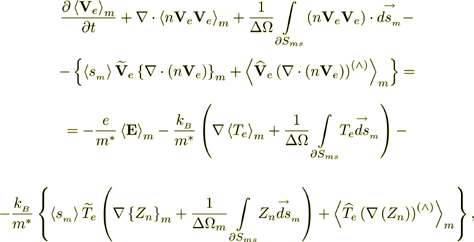 (15)
(15)where the last term on the right hand side of (12), the scattering and collision reflection term, has been replaced by a number of terms, each reflecting interface specific phenomena including scattering and collision. Some manipulation of the convection terms of the conservative form of the momentum equation has been done to combine the forms of the equations of mass and momentum.
The second conservative form of the momentum equation is derived in the form
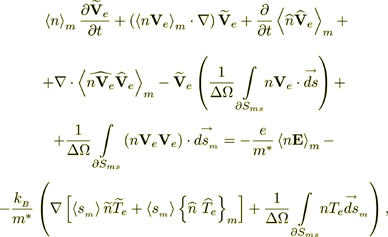 (16)
(16)where a number of the integral terms are scattering and collision terms. There are other possible forms of the left hand side of the momentum equation - HSP-VAT equations that will not be pursued at this time.
The homogeneous volume averaged electron gas energy equation for a heterogeneous polycrystalline becomes
 (17)
(17)or
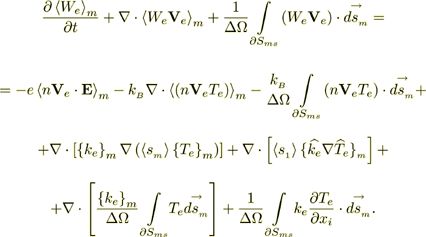 (18)
(18)The integral terms again reflect scattering and collision that appear as a result of the heterogeneous media transport description.
The equation for longitudinal phonon temperature is
 (19)
(19)or
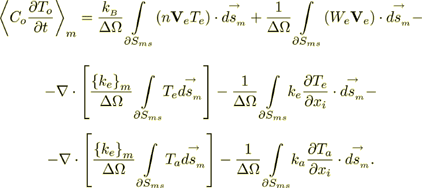 (20)
(20)The equation of acoustical phonon energy is
 (21)
(21)or
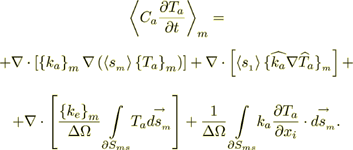 (22)
(22)Describing phonon scattering and collision as an unsolved problem and as noted by Peterson (1994) "the complexity of this aspect of the problem precludes the relatively simple solution used in simulating rarefied gas flows."
Another kind of single phase equation for momentum transport of electronic fluid results for magnetized materials
 (23)
(23)The VAT form of this equation is
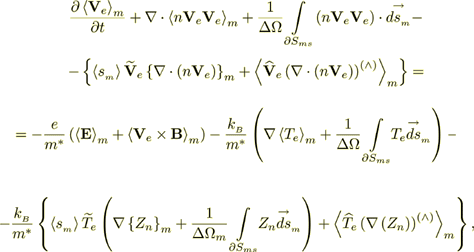 (24)
(24)Now we will add here for the completeness of the picture the averaged nonlinear equation for the electric potential
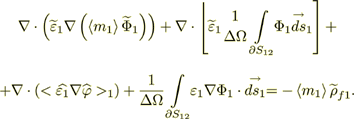 (25)
(25)
Here is the answer to that question above - Why not having the same kind of term and in the electrostatics GE?
Yes, this should be also the term(s) reflecting the collective processes of local-non-local atomic scale
electrodynamics with the "nano-micro-electrodynamics" of the lattice etc., etc.
The following remark is worth to read up as soon as we need to point out that - the second (Upper) scale governing averaged equations in this above set of HSP-VAT heterogeneous solid state plasma are only good if we know that the starting, the Lower scale equations were also correct. This we can not say about those above lower scale solid state plasma equations taken mostly following the paper by Majumdar et al. (1995). In these equations all the variables and the equations themselves are supposed to be as the already "averaged" ones, but they are not.
To have the more correct solid multicrystalline state HSP-VAT scaled mathematical model we have to accept the idea of AT LEAST the three scales taken into consideration. The Lower is the scale of really sub-atomic, inter-atomic size range, then the second (Intermediate) scale model that is within the single crystal (even imperfect crystal) and then the Upper (third) scale with the modeling equations for the solid state piece as it is assumed to be taken for continuum description.
See on the above remark in the subsection -